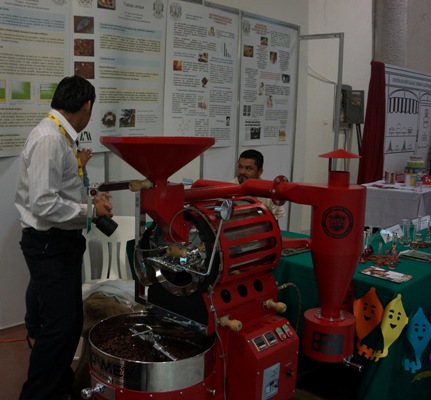
|
There is no better way to immerse oneself in the cultural history of chocolate than to travel to Tabasco, Mexico for the Festival del Chocolate. It is in that state, smaller than Vermont, where more than 70 percent of the country’s cacao is grown. And for five days in mid-November, in the capital city of Villahermosa, chocolate is celebrated in every way possible.

|
| Linda Rice Lorenzetti |
Mexico may be our close southern neighbor, but spending time there can make you feel like you have entered a world apart. Enveloped in tropical warmth and humidity, colorful trees and plants flourish so abundantly they still hide ancient ruins where cacao played an important role in daily life. Today, the region’s abundant rain, rich soil and warm temperatures make it the perfect place for the cocoa tree to flourish — a setting that combines a history spanning centuries and civilizations.
To attend the Tabasco Festival is to immerse oneself in all facets of that amazing culture. As Thelma Beltrán from the Convention and Tourism Office explains, ‘we are having an awareness of chocolate and beginning to understand our cacao roots here in Tabasco.’
The first thing that could be noticed when approaching the Parque Tabasco (Tabasco Park) was that its facade had been transformed into a hacienda. The transformation was so convincing and inviting it was hard to pass up a seat on the veranda. Nonetheless, no time to daydream — there was far too much going on to idle away the day.
Inside was a hub of activity with more than 75 exhibitors from all over Mexico. What notably differentiated this festival from others like it was the strong cultural component that one sensed everywhere. Not only were there fine chocolates but hand-carved wooden spoons and terra cotta cookware. Beverage makers offered not just the standard chocolate liquor or wine, but also unusual historical drinks of varying viscosity and color. In pop-up museums, there were certified reproductions of cocoa artifacts while chocolatiers had offerings ranging from simple dipped marshmallows to Belgian-style bonbons. But even the bonbons had a Mexican twist. Sophie Vanderbecken from Le Caméléon offered one made with chapulines (grasshoppers) which gave a distinctive flavor and a noticeable crunch.
Another cultural component was the juried art show where each painting had a cocoa theme. There were cocoa trees of amazing color, variety and setting, with Aztec warriors and princesses sitting under them and famed Mexican painter Frida Kahlo holding colorful pods. Coming from the United States — where few people even know what a cocoa pod looks like — the paintings provided interesting insight into how pervasively cocoa is connected with Mexican folklore.
Nearby was a detailed world history of cocoa, from the Maya and Aztec civilizations to Europe and beyond — including an 1894 chocolate-layer cake recipe used by the White House during Grover Cleveland’s administration. How cocoa transitioned from the spicy, unsweetened drink made from the bean Hernando Cortez took back to Spain into the confection we know today is a fascinating tale. That history, we were often reminded, is deeply rooted in Mexican culture.
Outside the exposition hall, Willie Wonka and other chocolate-themed movies were projected onto a large screen, while inside vendors were selling modern roasting and grinding machines. But even there one saw the contrast; not far from the shiny state-of-the-art equipment visitors could find hand- carved molinillos, used at least since the time of the Spanish for frothing chocolate. Or newly made stone metates used to grind cacao beans in the exact same style as the ones seen in local archaeological museums. These ancient kitchen gadgets have remained unchanged throughout the centuries.
A guided tour through Villahermosa’s city market, Mercado Pino Suarez, provided visitors a chance to find locally produced chocolate and sample drinks made from it. Chef Ernesto Aguilera maneuvered a dozen conference attendees through the densely crowded aisles. It was next to impossible to stay focused on just chocolate in the midst of pigs’ heads hanging from nearby rafters, huge tables laden with fresh fish, discouragingly long lines waiting for hot churros dusted with sugar, sweet tamales and corn cakes the likes of which we had never tasted, local cheeses, herbs, fruits and candies. It was a mind-boggling experience.
In a far corner of the market, we watched vendors grind corn and cocoa beans for posol, which is mixed with water to make a cold regional beverage. By morning’s end, not only was everyone’s stomach satisfied but shopping bags were full to overflowing. Even the chefs’ bags were laden. Margarita Carrilloa, executive chef at Turtux in Mexico City, explained she wouldn’t be able to find any of what she just purchased back there because it was specific to the cuisine of Tabasco. The title of Carrilloa’s presentation the day before had been ‘The Importance of Ingredient and the Pride of Being Mexican’ and judging from the heft of her market bag, at that moment she must have been feeling very proud.
Back at the Festival, chocolate traditions, secrets and recipes were being shared by more than twenty chefs and chocolatiers. Abigail Mendoza Ruiz, whose well-known restaurant Tlamanalli is in the Zapotec town of Teotitlan del Valle, was amongst them. Using unrefined sugar, cinnamon and vanilla, she demonstrated the making of atole, another traditional masa-based chocolate drink that is often served on Mexican holidays such as the Day of the Dead.
Diana Kennedy, the noted cookbook author — whose life’s work is documenting the regional cuisines of Mexico — spoke to university students on gastronomy. The packed room of students listened attentively while Kennedy spoke for the better part of an hour about her love of and concern for food.
But then each presentation drew an enthusiastic audience. Simultaneously, workshop participants were invited to crack open fresh cocoa pods to taste the pulp, sample old world beverages, or pair chocolate with modern day wines, olive oils and beers. For those interested in the historical aspects of chocolate, there were scholarly lectures on its complex history and origin – from preHispanic Mayans to the present – even one entitled Monkeys and Cacao which explored the notion that it was monkeys who were largely responsible for spreading the cacao bean from the Amazon basin to Central America.
In ancestral tradition, Festival attendees could participate in a Barter Market. For bringing in recyclables they received cocoa beans to barter for souvenirs, food and drink. What better way to teach history in a modern context, particularly since cacao beans were actually used as currency in Mesoamerica before the Spanish arrival?
The evening hours brought yet more offerings. At Sabor a Tabasco one could sample regional food from local restaurants while Noches de Vino was one of the many wine pairing and tasting experiences that were available. By then, mystical music — played on indigenous instruments made from shells, drums, clay whistles, gourds, seeds, turtle shell, bamboo and local wood — filled the building. Being lulled by the old world music brought notions of antiquity back to the forefront — another gentle reminder that chocolate in Mexico is deeply grounded in history and tradition.
Linda Rice Lorenzetti is a correspondent for Candy Industry Magazine. Together with her husband, documentary photographer Daniel Lorenzetti, they are working on a project entitled The Birth of Chocolate (www.birthofchocolate.com)
